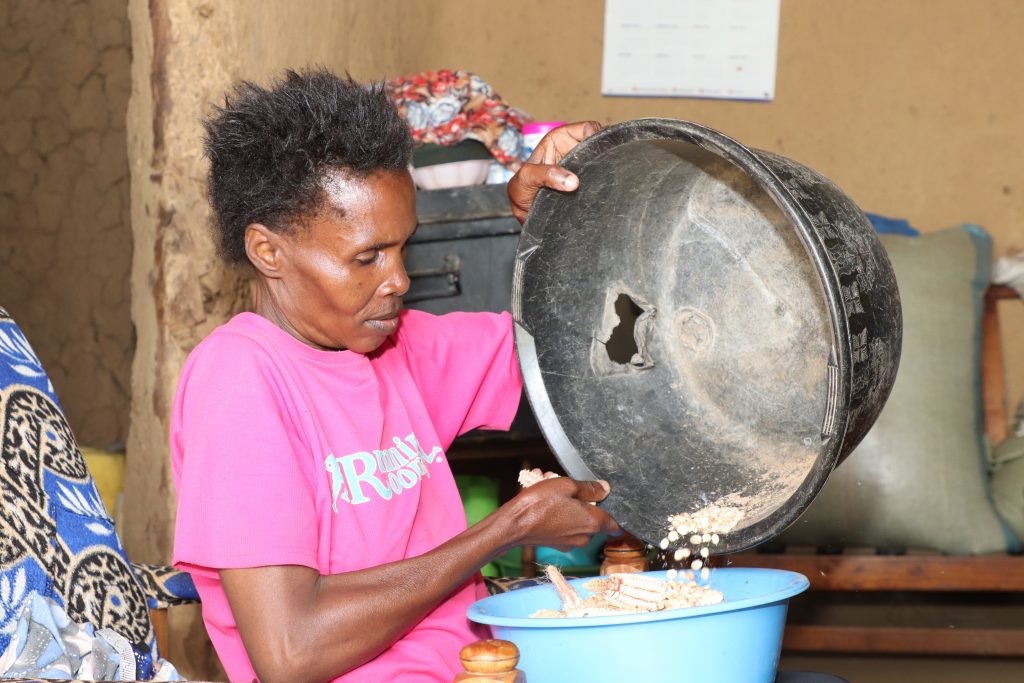There is hope. TB is treatable and curable; Mary Auma
At Wagai Dispensary, a facility popularly known by the local people as Nyagondo, a meeting is held every Monday morning to review TB cases at the facility targeting to establish the best intervention measures per case. Healthcare workers are encouraged to submit any concerns they have about a particular case.
At one particular time, a unique case was brought to the attention of the meeting. It was about a patient who had been confined to bed for about six months.
According to Gem Sub-County TB and Leprosy Coordinator, Collins Omondi, the diagnosis was not clear. He took the initiative and rode with a healthcare worker on his motorbike to the patient’s home.
They found Mary Auma Omollo bedridden. She complained of stomach pains that had persisted for about six months, making it hard for her to walk. She also was unable to eat. After a thorough examination, she was clinically diagnosed with TB.
“Since Mary Auma wasn’t able to walk, we checked her for trauma signs and found none. We took her history and upon subjecting her to a physical examination, we realized that there was a deformity on the spine. This was the answer to the question that ailed her. She had Pott disease also known as TB of the spine. With this diagnosis, we were optimistic that Mary Auma would be treated and cured”, says Collins.
This fifty-year-old woman, a mother of six children who lost her husband in 2005 and later re-married through a traditional wife inheritance arrangement, says before she was diagnosed with TB, she experienced untold suffering.
“My body was in a never-ending pain; I couldn’t move or do anything for myself including the simplest things such as going to the toilet. To make matters even worse, my beloved ones deserted me, they left me to die”, says Auma.
The disease, Mary says, began with a problem in her stomach sometime back in August 2019. Whenever she was walking, the pain became severe and thus walked with a stoop which to her mind helped in easing the pain. When she met people, at times, she pretended to be searching for something or dusting her feet just to evade awkward questions.
Several times she visited Nyagodo hospital but each time the treatment didn’t work. The prescriptions were pain relievers. The pain would ebb away and then reoccur.
At one point, she was referred to Yala hospital for further examination which she managed with her daughter’s support. She was found with a condition in her stomach that required an operation. Unfortunately, due to financial limitations, she wasn’t able to go on with the procedure. She went back home and her condition aggravated.
The stigma demoralized her even more. Only a few people associated with her. Others said she was bewitched. Her solution, they advised was the traditional medicines and prayers.
“We counselled her to have faith in the treatment process and avoid using herbal medicines having gone from one facility to another without success”, says the Gem STLC.
She wasn’t shocked when she was found with TB, she says. It was a respite, a major break from using herbal concoctions that made no difference to drinking raw blood in an effort to increase blood count which at the end of the day yielded no results. It was like fighting an indefinable enemy. She embarked on her medication with hope that TB is treatable and curable just like she had been assured by healthcare workers.
“After taking the drugs for a while I saw significant changes, the doctors would also visit me weekly to check my progress. They encouraged me to keep on going with the treatment. I would send my children to collect my packs from the hospital. I was given a month’s pack to ensure that my child who collected them for me didn’t miss a lot on his syllabus coverage”, she says.
Her children would come from school in the evening and clean her bed from where she would answer calls of nature as she couldn’t walk, cook food and remind her to take her TB drugs. During the day when her children were in school as she had no one to take care of her, Mary Auma would eat the previous days leftovers and stay in bed.
The TB drugs had no side effects on her but she faced a challenge with an insufficient supply of food. Auma mainly depended on ready-to-use therapeutic food and fortified blended flour, treatment supplements, which she refers to as “porridge flour”, that she got from the facility. She was also given a monthly stipend. After taking the drugs for one year, she was declared TB free. Although her back is still swollen, she is able to walk.
Mary Auma is grateful for the support accorded to her by healthcare workers, especially for committing themselves to treat her from home. She appreciates government for providing TB treatment for free. She resiliently fought TB and implores people not to be judgmental and discriminatory of TB clients. She opines that being supportive helps one get better quickly.
The healthcare workers at Nyagondo dispensary are happy that the support they are getting from the government and partners in finding and treating TB is paying off. “We thank God Auma is cured; we also thank the National TB program for supporting activities that help ease the burden of treatment on needy people. Were it not for the provision of drugs and the training they have given us, this wouldn’t have been possible. We also thank the staff who are very passionate about their work. Mary Auma can be one but there are quite a number in the villages and we must find and treat them”, says the Gem STLC.
Read more uplifting stories on https://www.nltp.co.ke/wp-content/uploads/2022/09/Tiba-Newsletter_Edition-10_2022_Final.pdf


Very good testimony